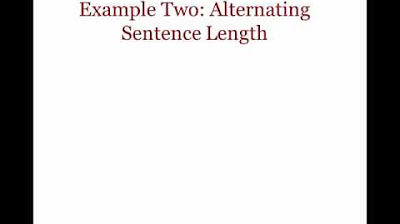Kesalahan Umum dalam Menulis
Summary
TLDRIn this video, the speaker shares essential writing tips, emphasizing the importance of a strong first sentence to captivate the reader and maintain engagement. The speaker guides viewers through the process of determining the purpose of their writing and structuring it accordingly, comparing writing to building a house where planning and organization are key. The content also stresses the importance of having a clear outline and ensuring every element aligns with the writing's goals. The video serves as a foundation for those interested in writing, whether for academic, journalistic, or creative purposes.
Takeaways
- 😀 The first sentence of any writing should grab the reader's attention and make them want to continue reading.
- 😀 It's important to identify the purpose of your writing before starting. Whether it's an academic paper, a video script, or journalism, the purpose will shape your writing approach.
- 😀 Creating a structure (or outline) is crucial. Just as a house needs a blueprint, your writing needs a plan to ensure clarity and organization.
- 😀 Different types of writing require different structures. For example, news articles follow the 5W1H structure, while fiction writing allows for more flexibility.
- 😀 When creating an outline, it's essential to organize your ideas and arguments in a way that best supports your objective.
- 😀 Don't be afraid to remove irrelevant information, even if it came from extensive research. Relevance to the goal of the piece is key.
- 😀 If you find yourself confused about what to write next, it's a sign that your outline might not be strong enough. Review and revise your structure before continuing.
- 😀 The first sentence plays a key role in establishing the tone, rhythm, and perspective of your writing. It sets the stage for the reader’s experience.
- 😀 Many beginners hold back from placing the most exciting or interesting elements at the start of their writing, but this can hurt engagement. The best writing starts strong from the beginning.
- 😀 A well-crafted first sentence can immerse the reader in a new world or provoke thought, making them want to read more.
- 😀 Writing is a process. After structuring your content and testing your outline, take the time needed to refine and ensure your writing is engaging from start to finish.
Q & A
What is the first step to consider when starting to write?
-The first step is to define the purpose of your writing. You must know the reason behind your writing, whether it's for a thesis, an article, or fiction, as this will guide your process.
Why is it important to prepare an outline before writing?
-An outline acts as a blueprint for your writing. It helps organize your thoughts, structure your content effectively, and ensures you stay on track with your writing goals.
How do writing structures vary between different types of writing?
-The structure differs depending on the type of writing. For example, news articles usually follow a 5W1H structure (Who, What, Where, When, Why, How), while fiction can be more flexible, allowing for creative freedom in how the story unfolds.
What should be done once you have gathered all the elements for your writing?
-Once the elements are gathered, you should organize them logically and test if the structure aligns with your writing goal. Irrelevant or unnecessary information should be discarded.
Why is the first sentence of a piece so important?
-The first sentence sets the tone, rhythm, and perspective of the entire piece. It should grab the reader's attention and motivate them to continue reading.
What is a common mistake writers make with their first sentences?
-A common mistake is being hesitant or holding back from making the first sentence compelling. Writers may avoid placing the most interesting parts at the start, fearing they might run out of material, but the first sentence should be strong enough to engage the reader.
How should a writer approach organizing their argument or information in an outline?
-Writers should carefully plan where each element fits within the outline. For example, the main argument should be placed clearly, and supporting data or theories should be organized where they make the most impact.
What should a writer do if they feel lost during the writing process?
-If a writer feels lost, it’s essential to revisit the outline. If the structure isn’t solid enough to guide them, it might need to be adjusted or refined before continuing with the writing.
How do you ensure that the content is relevant to your goal?
-Review your outline and the gathered elements to check if they align with your original writing goal. If certain information doesn't serve the purpose, it should be cut, regardless of the effort put into gathering it.
Why is it necessary to be ruthless when editing out irrelevant information?
-Being ruthless in editing ensures that only the most relevant and useful information remains in your piece. It helps improve clarity and prevents the writing from becoming cluttered with unnecessary details.
Outlines

This section is available to paid users only. Please upgrade to access this part.
Upgrade NowMindmap

This section is available to paid users only. Please upgrade to access this part.
Upgrade NowKeywords

This section is available to paid users only. Please upgrade to access this part.
Upgrade NowHighlights

This section is available to paid users only. Please upgrade to access this part.
Upgrade NowTranscripts

This section is available to paid users only. Please upgrade to access this part.
Upgrade NowBrowse More Related Video

Sentence Variation

How to Write a Personal Narrative | Introduction & Brainstorming (Day 1)

How to Create Irresistible Hooks (and blow up your content)

Redação DOS FATOS petição inicial

5 Tips Menulis Kreatif yang Bisa Memikat Pembaca

Improve Your Academic Writing | 7 Useful Tips to Become a Better Writer ✍️
5.0 / 5 (0 votes)